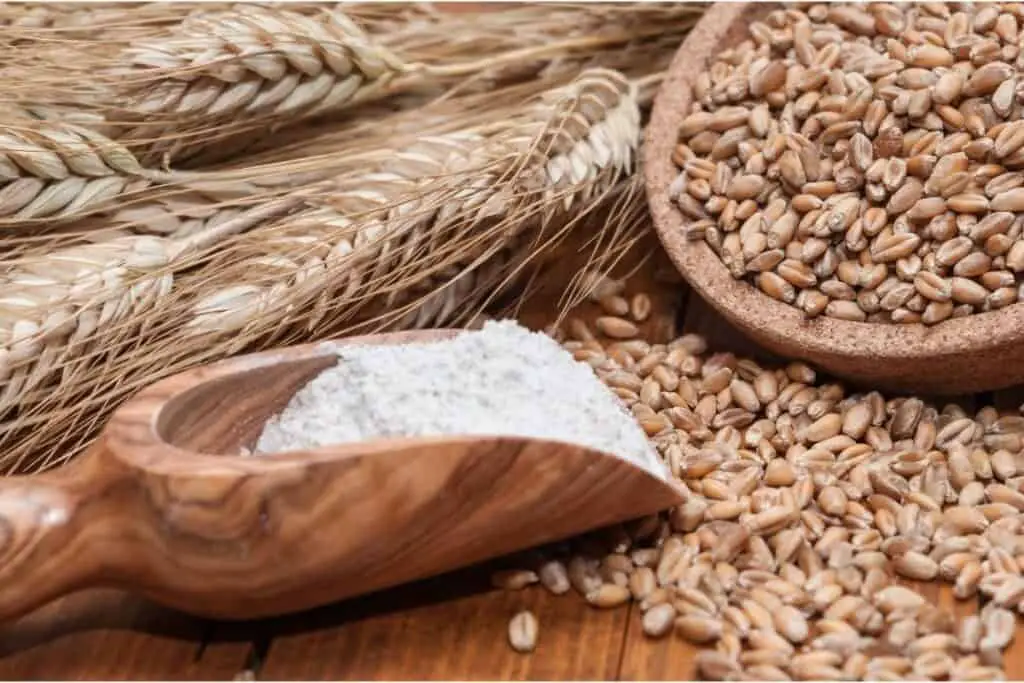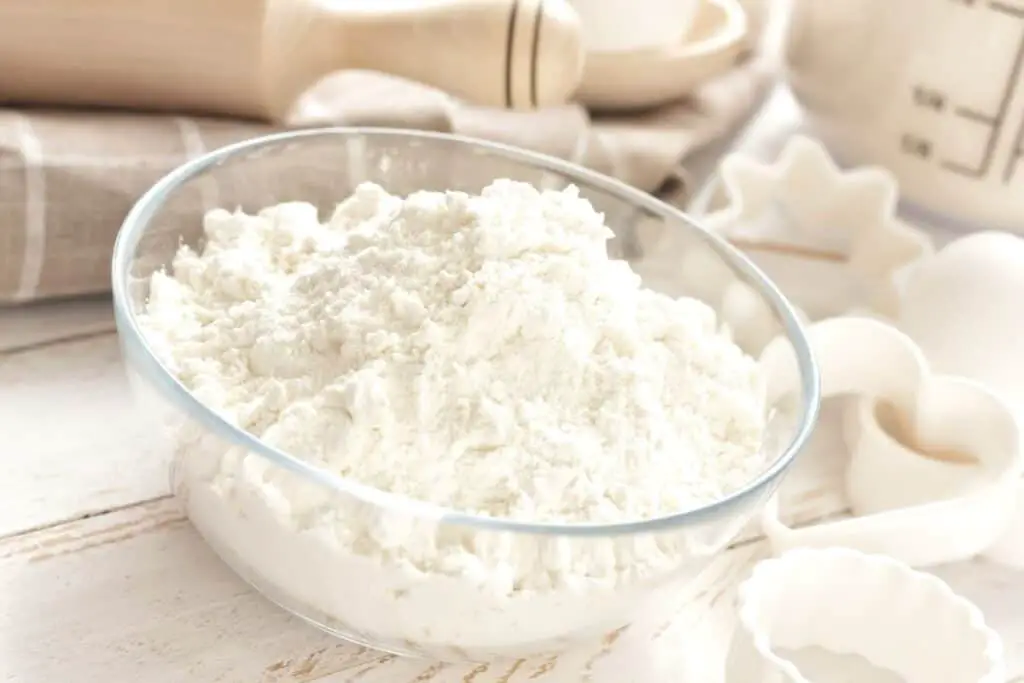Pumpernickel is a unique type of flour to say the least. It makes delicious pumpernickel bread, which originated from Europe.
What distinguishes pumpernickel flour from rye flour is that it is made from whole rye berries.

Pumpernickel is made by grinding up the entire rye berry, whereas regular rye bread is made by grinding up just the endosperm.
White rye flour is made by grinding the white center endosperm portion of the rye berry. Dark rye is made from ground whole grain rye flour mixed with some black rye flour. It has a darker color than regular rye bread.
Pumpernickel flour is also colored and sweetened with brown sugar and molasses to make pumpernickel bread.
It also gets its darker color as the flour uses more of the outer endosperm, which contains more of the pigment from the rye berry. This is why pumpernickel is darker than regular rye bread.
Pumpernickel bread is a type of dark rye bread that has a distinctive flavor. The bread was originally created in Germany, but today it’s also widely eaten in other countries. What makes this bread special?
Because pumpernickel flour is made from whole rye berries, this type of flour contains more protein than regular white flour, which means it helps build muscle mass.
It’s important to note that pumpernickel bread isn’t gluten free. Gluten is a protein found in wheat, barley, and rye. If you have celiac disease or another gluten intolerance, you should avoid pumpernickel bread.
The German style of bread includes a sourdough starter and sometimes yeast with the flour. The dough then cooks in loaf tins for up to 24 hours at a low heat. It takes a long period of time to bake the bread, giving it a dark color.
The American style bread usually doesn’t include sourdough starter, so there’s no need for a long cooking time. It gets its dark color from adding ingredients like coffee, chocolate, or molasses.
What Is In Pumpernickel Flour?
Pumpernickel flour is made entirely from coarsely ground rye berries. When made into pumpernickel bread, brown sugar or molasses is added to it for color and sweetness.
How Do I Make Pumpernickel Bread at Home?
Making your own pumpernickel bread is easy! All you require is some basic kitchen equipment. Here’s what you will need:
- A kitchen scale
- A baking pan
- Bread cutter
- Baking sheet
- Heavy-duty cutting board
- Measuring cup
- Wooden spoon
Now that you’ve got all you need, let’s see how you can make pumpernickel bread.
Step 1 – Measure the Ingredients
Measure out all the ingredients for your homemade pumpernickel bread recipe. You can use any measuring cup you like, as long as it measures accurately.
Step 2 – Mix the Dough
Combine the dry ingredients (whole rye flour, salt, brown sugar) with the wet ingredients (water). Use a wooden spoon to mix everything together until well combined.
Step 3 – Knead the Dough
Kneading dough is an essential step when making bread. It helps develop the gluten structure so that the loaf rises properly.
To knead the dough, first combine the dry ingredients into one bowl. Then add the water and stir with a wooden spoon. Next, turn the dough onto a clean surface and begin to knead the dough.
Work quickly and gently by folding the dough over itself several times. Continue to work the dough until it becomes smooth and elastic.
Step 4 – Let the Dough Rest
After mixing and kneading the dough, let it rest for about 10 minutes before shaping it into a ball. During this resting time, the gluten develops further and the dough relaxes. This allows the loaf to rise better.
Step 5 – Shape the Loaf
Shape the dough into a ball. Place the dough on a lightly floured surface and roll it out to form an 8-inch circle. Cut the circle into eight equal wedges using a bread cutter.
Step 6 – Proof the Loaves
Cover the loaves with plastic wrap and allow them to proof for 45 minutes. After 45 minutes, remove the plastic wrap and brush the top of each loaf with milk.
Once the dough has risen, divide it into two equal parts. Roll each part into a log shape using a rolling pin. Cut the logs into slices using a bread slicer. Place the sliced loaves on a greased baking sheet.
Step 7 – Bake the Loaves
Place each piece of dough on a greased baking sheet. Bake them in a preheated oven at 350 °F (176.67 °C) for 25 minutes. Remove the loaves from the oven once they start to brown slightly.
Step 8 – Cooling Time
Let the bread cool completely before slicing.
Step 9 – Enjoy Your Homemade Pumpernickel Bread
Once cooled, slice the bread and enjoy! Store leftover bread in an airtight container for up to five days.
What Are The Benefits Of Eating Pumpernickel Bread?

Pumpernickel bread is delicious because of its strong flavors, and dense texture. It also contains less fat than other types of bread.
Pumpernickel bread is high in fiber and low in calories. Fiber is an important component of healthy diets. Eating more fiber may help lower cholesterol levels and reduce the risk of heart disease.
Pumpernickel has been shown to improve blood pressure and lower cholesterol levels. They contain soluble fibers which bind to cholesterol and remove it from the body.
Pumpernickel bread is easy to make. All you need is some basic kitchen equipment and ingredients.
Why Is It Called Pumpernickel?
You may already be familiar with pumpernickel bread, but do you know how it got its name? Pumpernickel is dark and hearty, and has a taste similar to rye bread, but where does the name “pumpernickel” come from?
Pumpernickel bread is a type of dark rye bread that originated in Germany. The origin of the term “pumpernickel” is pretty interesting: It’s a German term for “to break wind,” and “Nickel,” a play on the name Nicholas, is associated with goblins or devils.
It comes from the bread’s reputed digestibility, or rather its lack thereof. Essentially, roughly translated, “pumpernickel” is “devil’s fart”.
What Is Dark Pumpernickel Flour?
Dark pumpernickel flour is made by grinding whole rye berries that are then combined with brown sugar, molasses, or even coffee.
This mixture is then sifted through a fine mesh screen to separate the bran from the endosperm (the starchy portion). The resulting flour is darker and richer tasting than regular all purpose flour or regular rye flour.
Dark pumpernickel flour can be used in place of regular all-purpose flour in most recipes.
Is Pumpernickel Flour The Same As Rye Flour?
Pumpernickel flour is also made from rye, but it uses the whole rye berry, which is coarsely ground.
Pumpernickel loaves tend to be dense, dark, and strongly flavored.
Rye flour is ground using only the central portion of the rye berry, rather than the entire berry. This flour doesn’t contain any of the outer seed coat, the bran, or the germ, so the end product stays fairly light in color compared to pumpernickel flour.
How Is Pumpernickel Meal Different From Pumpernickel Flour?
Pumpernickel meal, or “rye meal”, is the whole ground rye berries that make up pumpernickel flour. The whole rye berries are coarsely ground up to make pumpernickel flour.
What Does Pumpernickel Flour Taste Like?
Pumpernickel flour makes bread that is dark and strong-tasting. Pumpernickel also has a slight sweetness to it, thanks to the addition of brown sugar or molasses, which also gives it its iconic color.
Substitutes For Pumpernickel Flour
Although pumpernickel flour is essential for making authentic pumpernickel bread, you can use other types of flour such as buckwheat, almond flour, or pecan flour instead, although it may not produce bread with a similar taste or texture.
Can I Use Rye Flour For Pumpernickel Flour?

Pumpernickel flour requires “rye meal”, which is made from whole ground rye berries. This is what gives pumpernickel bread its unique color and flavor.
Can I Make Pumpernickel Flour?
Yes! You can grind your own rye berries into flour at home. Simply grind up whole rye berries, until coarsely ground.
This is the only ingredient to make pumpernickel flour. You can then add in brown sugar or molasses when making pumpernickel bread.
Pumpernickel Flour Nutrition
Pumpernickel is rich in dietary fiber, protein, iron, and B vitamins. It contains about 15% more protein than wheat flour.
Is Pumpernickel Flour Gluten-free?
Although pumpernickel does not contain wheat, it does, however, contain gluten. Therefore, pumpernickel flour or pumpernickel bread is not suitable for those with a gluten intolerance.
Best Uses for Pumpernickel Flour
You can use pumpernickel flour in place of regular all purpose flour in almost any recipe.
However, you should note that pumpernickel flour tends to have a denser texture than other flours, so you may need to adjust the amount of liquid in your recipe accordingly.
The best use for pumpernickel flour, of course, is to make a delicious loaf of pumpernickel bread. Follow the recipe above to learn how you can make this yourself at home.
Where To Buy Pumpernickel Flour
You can purchase pumpernickel flour online, or at brick and mortar stores. It may be a little difficult to find in your local supermarket, but specialty baking goods stores will have it in stock.
Conclusion
Pumpernickel bread is an excellent choice for those who prefer darker tasting breads. It’s dense, hearty, and full of nutrients.
If you’re looking for a healthier alternative to traditional white bread, try our delicious pumpernickel bread recipe today.
